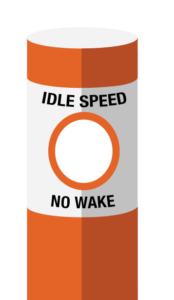
Lowest speed required for steering.
Example: The speed you use when docking

Settled in the water, not plowing.
Example: A speed that prevents the bow from rising

Free to resume a safe speed.
Example: A speed that allows you to proceed on plane
Danger
A diamond alerts boaters to hazards like shoals, rocks, and wrecks.

Restricted
A circle indicates areas where vessel operations are regulated.

Exclusion
A diamond with a cross indicates areas where boats are prohibited.

Information
A square provides information like directions, distances, and locations.

Southwest Florida boaters must rely on channel markers to avoid running into shoals, oyster beds, and other hazards. These aids indicate navigable channels, junctions and forks in a channel, the safest route to navigate around a hazard, and the safe centerline in wide bodies of water.
 “Red, right, returning.”
“Red, right, returning.”
When entering a channel from the open sea or traveling upstream (returning), keep the red markers on your right (starboard side).
Notice these red markers contain even numbers, which should increase as you proceed inland.

When traveling toward open water (seaward), keep the green markers on your right (starboard side).
The green markers contain odd numbers, which should decrease as you proceed toward open water.

Gulf Intracoastal Waterway (ICW) markers have an additional marking at the top. A small yellow square or triangle at the top of the marker indicates you are in the ICW. When traveling north in the ICW in Southwest Florida, always keep the yellow triangles to starboard and the yellow squares to port — no matter the marker color.

Tides and shoaling can change our underwater landscape. Keep an eye out for shallow water to avoid running aground.
Focus on the water, not your electronics! Watch for changes in the water color (polarized sunglasses help), birds standing in the water, and surface irregularities like waves breaking where they shouldn’t or slick areas in otherwise choppy water.
Maintain a speed that allows you to safely maneuver when overtaking or approaching another boat.

Vessel 1 approaching from right has right of way, maintains course and speed.
Vessel 2 must yield by slowing or altering course to avoid collision.
